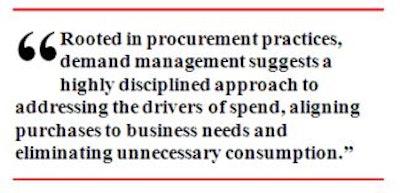
March 2, 2009 — The recent volatility of oil prices and the emerging global economic crisis have led to significant reductions in domestic and international capacity and, likely, to the airlines' subsequent move to add ancillary fees on top of rate increases as they combat continuous financial strain. Hotel room rates may still increase yet this year and into next despite new inventory coming online in relation to slowing demand. Car rental rates are also expected to increase to some degree.
With the overall cost of business travel on the rise and given today's industry and economic dynamics, companies are looking for strategies to further reduce costs without sacrificing the effectiveness of their overall travel program and without compromising a company's overall business goals and requirements. Demand management is the term widely used to describe these efforts.
Rooted in procurement practices, demand management suggests a highly disciplined approach to addressing the drivers of spend, aligning purchases to business needs and eliminating unnecessary consumption. While this is not an entirely new idea for many companies that have carefully monitored the purpose for business travel and performance of travelers for some time, there is certainly a new level of emphasis on, and interest in, this practice.
One definition for demand management states it is "a process that weighs revenue return against expense and productivity loss." In the travel arena specifically, this translates into a better understanding of the rationale behind business trips and a reduction in unnecessary travel. Demand management also considers alternatives for travel not classified as "strategic" or "revenue producing." An example would be using virtual meetings and video conferencing in place of some in-person internal meetings that may have involved air travel and/or a vehicle rental and a hotel stay.
More companies are integrating demand management initiatives into their travel programs. Some questions being considered:
Travel managers need to be careful not to take demand management too far in their travel program. Companies that have been through tough times before recognize that it is possible to cut too deep. Whether internal team or client-focused travel, business development efforts are even more critical during challenging times. For travel that is deemed necessary, remember that integrating the following into a corporate travel program also can help ensure travel of any kind is appropriate and mindful of a company's travel budget:
Online adoption — Savings from air, hotel and car suppliers represent a core component of travel management, but companies able to avoid unnecessary travel can record significant value. Many CWT clients in 2008 have been driving online adoption in conjunction with other technology to optimize travel spend.
Dynamic messaging — Many online booking tools (OBTs) use dynamic messaging, key messages that appear on screen for easy viewing by users. These messages alert travelers to new policies, internal meeting protocol, use of Web technology, altered advance purchase guidelines and more. In addition, some counselor- and online-booking systems provide rental car cost advantages versus limo and/or taxi usage for top cities. This point of sale technology may also offer tracking capabilities to identify those users not selecting the low-cost option.
Reason codes — Implementing reason codes is another effective way to identify why travelers do not choose a preferred supplier and/or accept a lowest logical rate. For example, when a traveler books an airline ticket with overnight travel but does not select a hotel, companies have the option to require the traveler specify a reason code explaining why they are not booking a hotel. In many cases, the traveler does not have a valid reason within policy; however, the request for documentation is often enough to encourage compliance. As discussed in CWT Vision North America Q108, this psychological phenomenon is an example of visual guilt.
Policy messaging tools — The use of automated e-mail messages sent to a traveler and their supervisor alerting them both of an out-of-policy booking for air, hotel and/or car can also be quite effective. Using this feature, travel buyers can customize messages, apply business unit specific policies and exclude select travelers from notification.
Reporting tools — Institute performance dashboard, key metric tracking and reporting to key decision makers and policy enforcement managers on a local or global scale. Key performance indicators include compliance with air booking rules, restricted airfare use, class of air service and hotel category booked, missed savings and the reasons associated, as well as the number of eligible air bookings without accompanying hotel reservations.
Rate caps — Identifying a price point cap on air, hotel or ground transportation charges per market and raising awareness amongst travelers about the rate caps is another simple but effective method for controlling costs. Many markets feature popular meeting destinations, so it is important for buyers and travelers to evaluate total cost and, in some cases, consider alternative locations.
Preferred supplier support — Follow travel policy guidelines around lowest logical fares but also encourage traveler use of preferred suppliers. Companies that consistently demonstrate strong usage of a preferred supplier have an advantage when it comes to future contract negotiations.
Reduction of upper-tier hotel properties — To further reduce expenses, travel managers are limiting the number of full-service hotels in their programs. Limited-service hotel rates are often available at a lower rate and typically still include Internet access and a complimentary breakfast, two key traveler amenities. In addition, these properties are often in close proximity to less costly restaurants, another point of savings.
Aggressively managing the travel policy and revising as necessary may seem obvious but should not be minimized. While the above strategies often yield significant savings, there are other tactical policy measures travel buyers can implement, including:
Implementation of an approval process to ensure a strong business case for any travel, along with tightened policy, together will be key in accurately managing costs.
In addition, keeping travelers within a negotiated program doesn't always occur through mandates, but often through more subtle methods, such as positive reinforcement and executive sponsorship. For example, companies can host road shows and travel fairs, hold information sessions online or through conference calls, and offer incentive and reward programs.
Despite softness in the economy, travel will always be a crucial component in reaching business goals and objectives for many companies. Demand for corporate travel will continue to exist, and management of this demand is clearly the next emerging savings trend.
With the overall cost of business travel on the rise and given today's industry and economic dynamics, companies are looking for strategies to further reduce costs without sacrificing the effectiveness of their overall travel program and without compromising a company's overall business goals and requirements. Demand management is the term widely used to describe these efforts.
Rooted in procurement practices, demand management suggests a highly disciplined approach to addressing the drivers of spend, aligning purchases to business needs and eliminating unnecessary consumption. While this is not an entirely new idea for many companies that have carefully monitored the purpose for business travel and performance of travelers for some time, there is certainly a new level of emphasis on, and interest in, this practice.
One definition for demand management states it is "a process that weighs revenue return against expense and productivity loss." In the travel arena specifically, this translates into a better understanding of the rationale behind business trips and a reduction in unnecessary travel. Demand management also considers alternatives for travel not classified as "strategic" or "revenue producing." An example would be using virtual meetings and video conferencing in place of some in-person internal meetings that may have involved air travel and/or a vehicle rental and a hotel stay.
More companies are integrating demand management initiatives into their travel programs. Some questions being considered:
- What are the objectives of a particular business trip?
- How will return on investment (ROI) be measured?
- Can the objectives be achieved through a means other than travel?
- What is the added value of taking this trip?
- Who needs to travel to reach the stated objective?
Travel managers need to be careful not to take demand management too far in their travel program. Companies that have been through tough times before recognize that it is possible to cut too deep. Whether internal team or client-focused travel, business development efforts are even more critical during challenging times. For travel that is deemed necessary, remember that integrating the following into a corporate travel program also can help ensure travel of any kind is appropriate and mindful of a company's travel budget:
Online adoption — Savings from air, hotel and car suppliers represent a core component of travel management, but companies able to avoid unnecessary travel can record significant value. Many CWT clients in 2008 have been driving online adoption in conjunction with other technology to optimize travel spend.
Dynamic messaging — Many online booking tools (OBTs) use dynamic messaging, key messages that appear on screen for easy viewing by users. These messages alert travelers to new policies, internal meeting protocol, use of Web technology, altered advance purchase guidelines and more. In addition, some counselor- and online-booking systems provide rental car cost advantages versus limo and/or taxi usage for top cities. This point of sale technology may also offer tracking capabilities to identify those users not selecting the low-cost option.
Reason codes — Implementing reason codes is another effective way to identify why travelers do not choose a preferred supplier and/or accept a lowest logical rate. For example, when a traveler books an airline ticket with overnight travel but does not select a hotel, companies have the option to require the traveler specify a reason code explaining why they are not booking a hotel. In many cases, the traveler does not have a valid reason within policy; however, the request for documentation is often enough to encourage compliance. As discussed in CWT Vision North America Q108, this psychological phenomenon is an example of visual guilt.
Policy messaging tools — The use of automated e-mail messages sent to a traveler and their supervisor alerting them both of an out-of-policy booking for air, hotel and/or car can also be quite effective. Using this feature, travel buyers can customize messages, apply business unit specific policies and exclude select travelers from notification.
Reporting tools — Institute performance dashboard, key metric tracking and reporting to key decision makers and policy enforcement managers on a local or global scale. Key performance indicators include compliance with air booking rules, restricted airfare use, class of air service and hotel category booked, missed savings and the reasons associated, as well as the number of eligible air bookings without accompanying hotel reservations.
Rate caps — Identifying a price point cap on air, hotel or ground transportation charges per market and raising awareness amongst travelers about the rate caps is another simple but effective method for controlling costs. Many markets feature popular meeting destinations, so it is important for buyers and travelers to evaluate total cost and, in some cases, consider alternative locations.
Preferred supplier support — Follow travel policy guidelines around lowest logical fares but also encourage traveler use of preferred suppliers. Companies that consistently demonstrate strong usage of a preferred supplier have an advantage when it comes to future contract negotiations.
Reduction of upper-tier hotel properties — To further reduce expenses, travel managers are limiting the number of full-service hotels in their programs. Limited-service hotel rates are often available at a lower rate and typically still include Internet access and a complimentary breakfast, two key traveler amenities. In addition, these properties are often in close proximity to less costly restaurants, another point of savings.
Aggressively managing the travel policy and revising as necessary may seem obvious but should not be minimized. While the above strategies often yield significant savings, there are other tactical policy measures travel buyers can implement, including:
- Require 14-day advance purchase
- Require lower meal reimbursements
- Reimburse for only one checked bag
- Require approval for international travel
- Require use of corporate card for reimbursement of T&E expenses (when accepted by merchant)
- Reduce or eliminate same day trips under most circumstances
- Source meetings in lower cost cities
- Eliminate reimbursement for trips initiated outside of the corporate travel program
- Eliminate reimbursement for airline clubs
- Target communications with specific messages tailored to specific traveler/travel arranger audiences, such as executives, road warriors and administrative support functions.
- Use calling cards instead of mobile phones when traveling internationally.
Implementation of an approval process to ensure a strong business case for any travel, along with tightened policy, together will be key in accurately managing costs.
In addition, keeping travelers within a negotiated program doesn't always occur through mandates, but often through more subtle methods, such as positive reinforcement and executive sponsorship. For example, companies can host road shows and travel fairs, hold information sessions online or through conference calls, and offer incentive and reward programs.
Despite softness in the economy, travel will always be a crucial component in reaching business goals and objectives for many companies. Demand for corporate travel will continue to exist, and management of this demand is clearly the next emerging savings trend.














![Pros To Know 2026 [color]](https://img.sdcexec.com/mindful/acbm/workspaces/default/uploads/2025/08/prostoknow-2026-color.mduFvhpgMk.png?ar=16%3A9&auto=format%2Ccompress&bg=fff&fill-color=fff&fit=fill&h=135&q=70&w=240)
